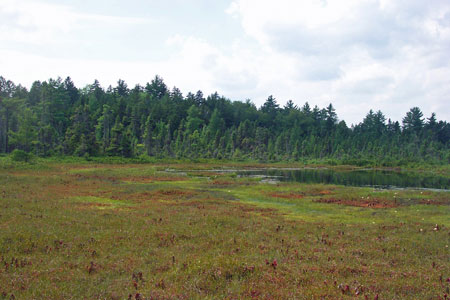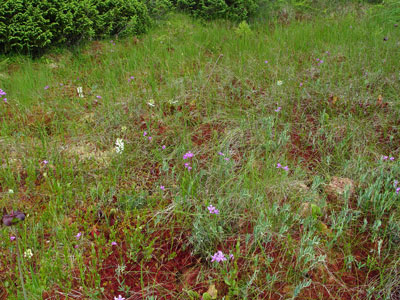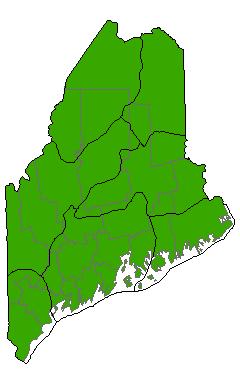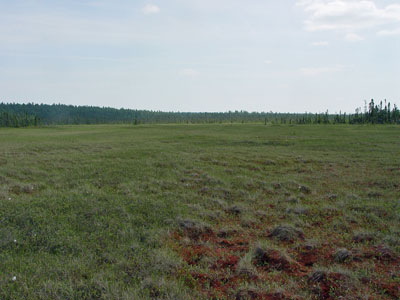DACF Home → Bureaus & Programs → Maine Natural Areas Program → Communities, Plants, and Animals → Natural Community Fact Sheets → Mossy Bog Mat
Printer Friendly Fact Sheet - 1.4 MB pdf (Get a free copy of Adobe Acrobat Reader)
Mossy Bog Mat
Scientific Name: Bog Moss Lawn; State Rank: S4

- Community Description
- Soil and Site Characteristics
- Diagnostics
- Similar Types
- Conservation, Wildlife and Management Considerations
- Distribution
- Characteristic Plants
- Associated Rare Plants
- Associated Rare Animals
- Examples on Conservation Lands You Can Visit
Community Description: The bryophyte layer is the most obvious component of this peatland type. A dense and usually very wet layer of peat mosses contributes most of the cover. Low herbs and stunted shrubs are often scattered across the moss lawn, but usually form <25% cover overall. Characteristic vascular plant species include leatherleaf, bog rosemary (very dwarfed), horned bladderwort, small cranberry, and white beak-rush. The most typical bryophytes are Sphagnum cuspidatum and bog-mat liverwort. Back to top.
Soil and Site Characteristics: Bog Moss Lawns occur within raised bogs and fens, typically in the wettest areas such as bog pools, boggy pond margins, and water tracks. They may form extensive areas on the higher areas of raised bogs. The substrate is highly acidic (pH ~ 4.0). Back to top.

Diagnostics: A carpet of bryophytes, mostly Sphagnum mosses, is the main feature in a peatland setting. Vascular plants generally contribute <25% cover. Back to top.
Similar Types: This is the only vegetation type in which bryophytes form the major continuous vegetation layer. Sedge - Heath Fens, Low Sedge Fens, and Leatherleaf Bogs can all have similar vascular plant species, but will have the vascular plants more strongly dominant (typically >50% cover). Back to top.
Conservation, Wildlife and Management Considerations: This community type is well represented in Maine and has been subject to few threats to date. Several examples occur on public lands and private conservation lands. Impoundment or draining would have negative impacts on bog hydrology and consequently on the vegetation. Slow vegetation growth rates, due to the nutrient-poor environment, result in slow recovery from physical disturbances, such as recreational trail use. If disturbance, such as foot traffic or logging access, is a necessity, traversing during frozen conditions or using boardwalks can minimize impacts.
Several rare dragonflies may be found in this community. Very wet locations with abundant inundated peat moss may host a number of uncommon damselflies and dragonflies including the Quebec emerald, zigzag darner, subarctic darner, incurvate emerald, and delicate emerald. Sites in northwestern Maine may include the bog fritillary butterfly, which uses small cranberry as its larval host plant. Back to top.
Distribution: Statewide, mostly from central Maine northward (New England - Adirondack and Laurentian Mixed Forest Provinces). Presumably extends westward, northward, and eastward from Maine. Landscape Pattern: Small Patch. Back to top.


Characteristic Plants: These plants are frequently found in this community type. Those with an asterisk are often diagnostic of this community.
- Dwarf Shrub
- Black crowberry
- Dwarf huckleberry
- Leatherleaf*
- Pale laurel
- Small cranberry
- Herb
- Horned bladderwort
- Pitcher plant
- Round-leaved sundew
- Tawny cotton-grass
- White beak-rush
- Bryoid
- Bog-mat liverwort
- Mylia liverwort
- Sphagnum mosses*
There are no documented rare plants associated with this natural community.
- Quebec emerald
Examples on Conservation Lands You Can Visit
| Example | County |
|---|---|
| Crystal Bog Preserve | Aroostook Co. |
| Great Heath Public Lands | Washington Co. |
| Number Five Bog Public Lands | Somerset Co. |
| Wiggins Brook, Squaw Mountain Public Lands | Piscataquis Co. |
